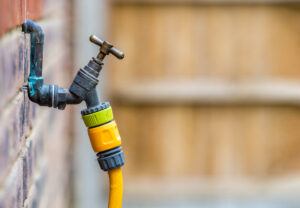
Now that winter is here with a vengeance, many of us are preparing to defend our homes against the cold. Among these seasonal tasks, one often slips under the radar – turning off outside taps. This seemingly small task is, in fact, a shield against significant damage and hefty repair bills. In this guide, we’ll not only walk you through the vital steps to safely turn off your outside tap, but also share with you why this chore is a cornerstone of winter home care.

Understanding the Importance of Shutting Off Your Outside Tap
Before delving into the ‘how-to’, it’s vital to understand why this task is so important. In freezing temperatures, water inside the pipes can freeze, expand, and cause the pipes to burst. This damage often goes unnoticed until the thaw, when the water starts to flow again, leading to potential flooding and significant repair costs. Now we understand why it is so important, let’s walk through how to turn off an outside tap.
Locating the Shut Off Valve
The first step is to locate the shut-off valve for your outside tap. In most UK homes, this is typically found under the kitchen sink or in the basement, where the main water line enters the house. It might be labelled or have a distinctive tap or lever.
Turning Off the Water Supply
Once you’ve located the shut-off valve, turn it clockwise to close it. This action stops the water flow to the outside tap. It’s important to do this gently to avoid damaging the valve.
Opening the Outside Tap
With the water supply turned off, go outside and turn on (open) the tap. This step releases any water remaining in the pipe. You might wonder why it is advisable to leave the tap open? The reason is simple: it prevents a build-up in the pipes of residual water that may freeze inside, reducing the risk of burst pipes.
Why Tap Covers are Beneficial
Tap covers are a simple yet effective way to add an extra layer of insulation to your outside taps. These covers are widely available online and in DIY shops and can be easily fitted over the tap to protect it from extreme temperatures.
The Consequences of Frozen Pipes
If water freezes in the pipes, it expands, causing the pipe to crack or burst. The real trouble starts when the ice thaws, leading to water leakage. This can not only cause structural damage to your home but can also be incredibly costly to repair. The inconvenience of dealing with water damage during the colder months adds to the turmoil, definitely an experience to avoid!
As you can see, the process of turning off your outside tap for the winter is simple yet crucial. By taking these preventative steps, you can protect your home from unnecessary damage and expenses. If you’re uncertain about any part of this process or need assistance, don’t hesitate to contact a professional plumber. Remember, a little precaution goes a long way in safeguarding your property.



